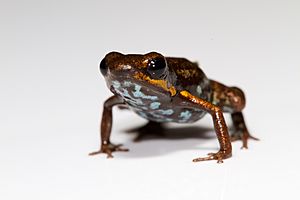Blue-bellied poison frog facts for kids
Quick facts for kids Blue-bellied poison frog |
|
|---|---|
 |
|
| Conservation status | |
| Scientific classification | |
| Synonyms | |
|
Dendrobates minutus minutus Shreve, 1935 |
The blue-bellied poison frog or bluebelly poison frog (Andinobates minutus) is a tiny, colorful frog from the Dendrobatidae family. These frogs are famous for their bright colors, which warn predators that they are poisonous. They are active during the day and live in the warm, wet forests of Colombia and Panama.
Contents
Where They Live
This small frog is found in the tropical lowland forests of Colombia and Panama. You can find them in areas like El Valle and Cerro Campana in Panama, and south to Rio Saija in Colombia. They usually live below 1,000 meters (about 3,300 feet) in elevation. They prefer moist forests and are often found on the ground among fallen leaves.
A Tiny Frog
As its scientific name, minutus, suggests, this frog is very small! It's only about 13 to 16 millimeters (about half an inch) long. That's roughly the size of your fingernail!
What They Eat
Andinobates minutus frogs are picky eaters. They mostly enjoy a diet of tiny creatures like mites (Acari), ants (Formicidae), springtails (Collembola), and different kinds of insect larvae.
Froggy Families
Blue-bellied poison frogs have an interesting way of raising their young. The female frog lays her eggs on the ground, often hidden in leaf litter. Once the eggs hatch, the male frog carries the tiny tadpoles on his back. He takes them to small pools of water that collect inside plants like bromeliads. The tadpoles then finish growing there until they become tiny frogs.
Why They Are Important
Poison dart frogs, including the blue-bellied poison frog, are known for their amazing colors. These bright colors are a warning sign called aposematic coloration. It tells predators that the frog's skin has toxic chemicals, making them unsafe to eat.
Threats to Their Home
Sadly, the blue-bellied poison frog is facing threats in its natural habitat. The biggest problem is habitat loss, mainly due to deforestation. Forests are being cut down for farming, logging, and building new homes. Pollution from various activities also harms their environment. Unlike some other poison frogs, this species is not usually collected for the pet trade. Protecting their forest homes is very important to help these tiny, colorful frogs survive.
See also
 In Spanish: Rana venenosa de vientre azul para niños
In Spanish: Rana venenosa de vientre azul para niños


